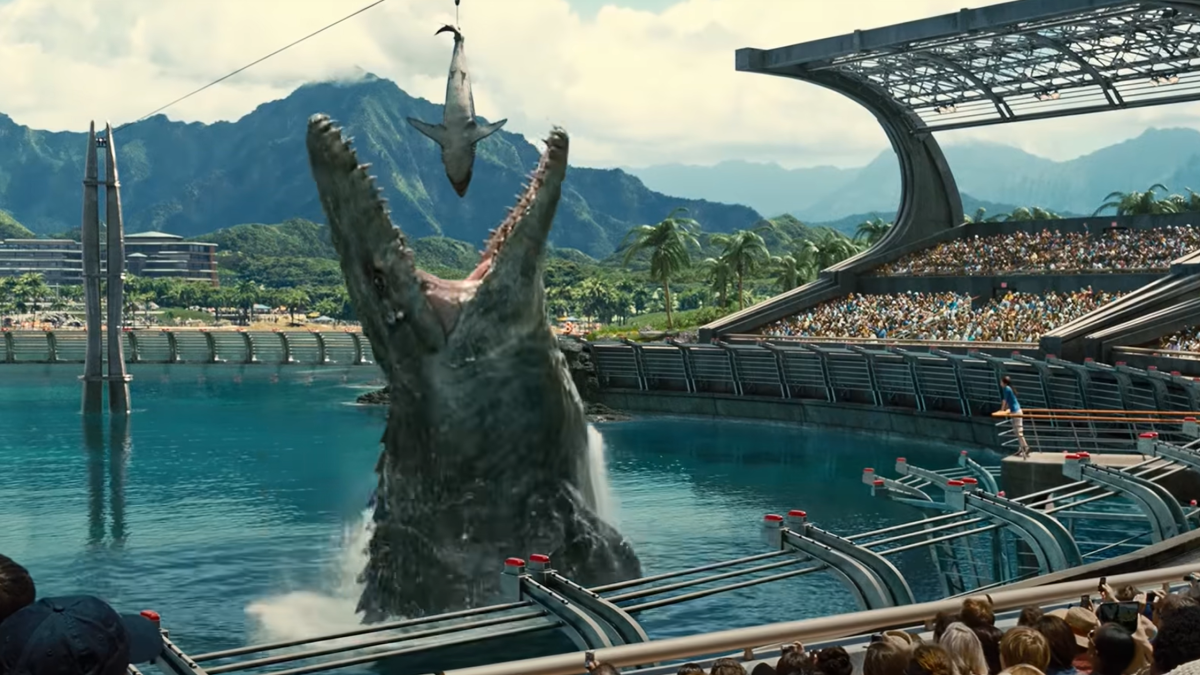If you, like me, never learned how to read, then Michael Crichton’s Jurassic Park duology was basically impenetrable. Luckily, we had the movies. More accurately, luckily, we had about one and a half of the movies. We had the rest of them regardless of luck.
But even with half a dozen feature-length entries in the motion picture franchise to work with, it’d be hard to fit all of the backstory that the notoriously verbose Crichton managed to plug into his books, like his pages-long descriptions of how Isla Nublar dealt with an endless amount of dinosaur poop in a limited amount of space (they stuck it on a boat) or why Hammond didn’t use his research to cure cancer (he was a jerk). Add to that the sequel films’ obligatory ante-upping in terms of visual spectacle and potential toy dinosaur sales, and there are going to be some plot holes.
Take, for example, the fact that the soft reboot park in Jurassic World features a respectable collection of aquatic creatures, most notably the Mosasaurus featured prominently in the film and its promotional material. As iconic shots from the second trilogy go, the river lizard popping up out of the water Planet Earth-style to chow down on a great white shark was right up there with Chris Pratt playing Cesar Millan with velociraptors.
But it also raises the sort of question that you really only think about after the buzz of watching dinosaur mayhem in Dolby surround sound wears off: How did the genetic engineers at Jurassic World get ahold of viable Mosasaurus DNA? The incomplete dinosaur DNA that they used to make all of the land dwelling dinosaurs was pulled from the abdomens of ancient mosquitoes trapped in amber. Mosquitoes don’t tend to make it too far out to sea, and if they did, they’d have a hard time getting a proboscis-full of subaquatic megafauna blood, thanks to the creatures’ likely substantial reserves of subcutaneous fat. Even a beached Mosasaurus would make for a pretty tough meal.
It turns out that the Jurassic franchise has offered a couple of explanations for how ocean critters might have been brought back to life.
The paleontological skullduggery of Jurassic World
It’s a funny thing, crazy-time made-up science. The secret seems to be making it seem just plausible-sounding enough to keep audiences on board without actually inventing something that’ll change the world. Jurassic Park set the baseline for the makey-ups that the rest of the series would lean on, and everything since then has had to live up to that standard. 2012’s Jurassic Park: Builder video game stated that water dwelling prehistoric critter DNA came from leeches frozen in ice – kind of a stretch, but so was the “Oops! All Amphibian Protandrous Hermaphroditism!” twist from the first story. Heck, so was finding unbroken strings of DNA in bugs thanks to the preservative power of pine pitch.
When Jurassic World came along, though, the higher ups knew that they’d need something more substantial than “worms instead of mosquitoes.” That’s why they did what all good speculative fiction writers do when the going gets tough: They made something up.

In the leadup to the release of Jurassic World, Universal put together a viral marketing website for the fictional Masrani corporation featured in the film. Do a little digging and you’ll find the logs of Doctor Henry Wu, the staple of the franchise who’s a researcher in the first movie, a villain in the fourth and fifth, and a cardigan in the shape of a man in Dominion. Wu’s logs reveal that the company was using a futuristic iron analyzer when they realized that, whoopsie doodle, the machine could detect viable DNA in Mosasaur fossils.
How? It doesn’t matter. Why? None of your business. In five sentences, the franchise swept an enormous plot hole under the rug, all thanks to a machine that, by the sounds of things, was really just designed to say “Yes sir, that’s iron” when you point it at some iron. It’s a little bit like saying “Success! We’ve discovered that our spectrometer can bring ghosts back to life” or “Eureka! Our geiger counter is also really good at counting calories!” but whatever. It’s a series about how a bunch of engineers kept dinosaurs from breeding by restructuring their genetics to make them all female instead of just neutering their pets the way Bob Barker on The Price is Right had been telling them to for the last thousand seasons. You get what you get.
Denial of responsibility! My Droll is an automatic aggregator of Global media. In each content, the hyperlink to the primary source is specified. All trademarks belong to their rightful owners, and all materials to their authors. For any complaint, please reach us at – [email protected]. We will take necessary action within 24 hours.


